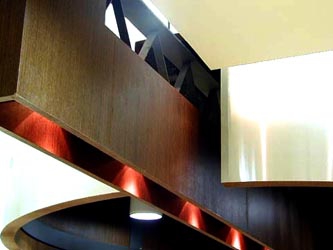Sep , 2002
現代消費者之福!

撰文/ 黃懷德
這幾年,百貨商場種類實在難以明確的切割定位,從傳統日式百貨。主題商場到所謂SHOPPING MALL,經營模式及空間交錯設定,甚至和不同類別的業種作某種程度的結合。尤其在國外,商場和飯店。商務旅館、遊樂園,甚至辦公大樓的雙向.多向經營,最典型的當然是結合電影院, 從建築體到室內的從新檢討,從規劃設定到實際經營操作,這些現象及被檢討,充分顯示出現代社會多元的商業需求及經營者長期歸納分析出的消費型態及走向。
要遷就的不只是既有建築體,
營業面積和空間及操作模式的定型,
長久以來的種種包袱才是其中難以克服的難題。
在臺灣,不難看見傳統百貨業的成長及變革,就座落地而言,從偏遠郊區的設定經驗,到選擇市郊的營運的實際案例,就建築室內的規劃切割來說,以傳統風貌呈現的已在少數,多半朝主題性。精緻化.年輕化等等的方式來提升空間質感,甚至藉此提高消費層次。但就經營面來說,多數仍舊脫離不開所謂專櫃式經營陰影,畢竟最直接的實際考慮仍是商場運作的基礎。
轉型,對任何業種都是困難的,尤其是已有營運歷史的更是不易,要遷就的不只是既有建築體,營業面積和空間及操作模式的定型,長久以來的種種包袱才是其中難以克服的難題。
消費者是所有的開端,也是整體流程結尾的一部份,我們能再短時間內享受無數人長期累積投入所營造出的整體感受,我們樂見將來的百貨型態更為多元豐富,從某個角度來看,這也是現代消費者的福氣吧。
現代消費者之福!

撰文/ 黃懷德
這幾年,百貨商場種類實在難以明確的切割定位,從傳統日式百貨。主題商場到所謂SHOPPING MALL,經營模式及空間交錯設定,甚至和不同類別的業種作某種程度的結合。尤其在國外,商場和飯店。商務旅館、遊樂園,甚至辦公大樓的雙向.多向經營,最典型的當然是結合電影院, 從建築體到室內的從新檢討,從規劃設定到實際經營操作,這些現象及被檢討,充分顯示出現代社會多元的商業需求及經營者長期歸納分析出的消費型態及走向。
要遷就的不只是既有建築體,
營業面積和空間及操作模式的定型,
長久以來的種種包袱才是其中難以克服的難題。
在臺灣,不難看見傳統百貨業的成長及變革,就座落地而言,從偏遠郊區的設定經驗,到選擇市郊的營運的實際案例,就建築室內的規劃切割來說,以傳統風貌呈現的已在少數,多半朝主題性。精緻化.年輕化等等的方式來提升空間質感,甚至藉此提高消費層次。但就經營面來說,多數仍舊脫離不開所謂專櫃式經營陰影,畢竟最直接的實際考慮仍是商場運作的基礎。
轉型,對任何業種都是困難的,尤其是已有營運歷史的更是不易,要遷就的不只是既有建築體,營業面積和空間及操作模式的定型,長久以來的種種包袱才是其中難以克服的難題。
消費者是所有的開端,也是整體流程結尾的一部份,我們能再短時間內享受無數人長期累積投入所營造出的整體感受,我們樂見將來的百貨型態更為多元豐富,從某個角度來看,這也是現代消費者的福氣吧。
The bliss of the modern consumer
By Roy Huang
Due to different management modes, the interlacing design of space or certain degree of integration with other industries, the division between department stores, traditional Japanese-style department stores, thematic supermarkets to the so-called “shopping malls” has become blurred in recent years. Malls, hotels, business hotels, amusement parks and even office buildings in other countries often adopted diversified management strategies, and typically integrate cinemas. The fact that the architecture, interior design, planning and actual operations have been reviewed indicates the need for a diversified economy in modern society and shown the consumer type and trend by long-term analysis of managers.
Accommodating the original architecture, business area and space,
as well as the fixed operation modes,
over the long-term imposes burdens of different kinds that form a kind of Gordian knot.
The development and reform of the traditional department store industry is obvious in Taiwan. As far as the location is concerned, we can see the actual change from rural locations to suburban areas; in terms of interior design, traditional designs have become rare and are replaced by thematic designs that aim at quality and youthful designs to improve the spatial quality and further enhance the level of consumption by various groups. However, as far as the management is concerned, most are still limited by boutique-style management practices. After all, direct and practical functions still remain the basis of business operations. Transformation is difficult for any business. It is particularly challenging for those with a long history of operation. In addition to accommodating to the original architecture, business area and space, as well as fixed operational modes, the long-term burdens of different kinds form a Gordian knot that they have to untie.
Consumers are both the beginning and end of the whole process. We can instantly enjoy the atmosphere established by the long-term devotion of numerous people; we are also happy to see a more diversified type of department stores in the future. From a certain perspective, this is the bliss of modern consumers.


